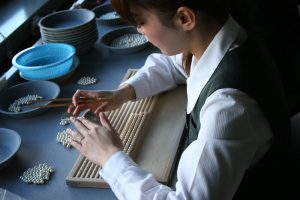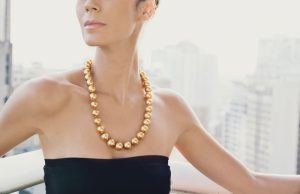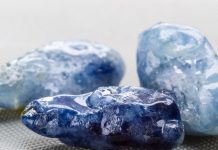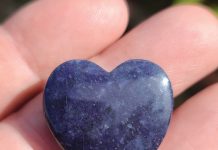
What are pearls? In the world of gems, pearls are unique. Unlike other gemstones, such as moonstone or emeralds, pearls form inside a living creature and are a true miracle of nature.

Pearls have been valued by human beings for thousands of years, with mentions of this precious gemstone appearing in the Bible and ancient Roman text. Pearls also had religious significance in ancient China, and are believed to have been associated with the moon and protection against dragons. Today, the pearl is associated with both innocence and inner strength and is the birthstone for the month of June.
Pearls are easier to come by these days than even a few hundred years ago, yet that hasn’t diminished their importance. They are still highly valued and sought after among lovers of fine gemstones.
Perliculture
Pearls were once found only inside mussels living in the wild, in lakes, rivers, and oceans. Until the late 1800s, pearls could only be harvested by divers, who had to gather thousands of mussels to find even one pearl among them. As a result, pearls were extremely rare and prohibitively expensive. But the advent of perliculture—the cultivation of pearls— was first perfected in Japan, making the pearl accessible to millions of people all around the world.
Today, the vast majority of pearls in the marketplace are cultured, meaning they were harvested on pearl farms. Most of these farms are located in the Far East, with China serving as home to the greatest number of pearl farms in the world.

Courtesy CPAA
The mussels that produce pearls can be found in both fresh and saltwater, depending on the species. Pearl farms using saltwater are located in coves or bays, while freshwater mussels for pearls are kept in ponds or former rice paddies.
Pearl MythsOver the millennium, pearls have become the subject of several myths. Here are some misconceptions and truths about pearls: MYTH: Wild pearls form when a grain of sand enters a mussel and becomes encased with hard matter as the creature’s body attempts to isolate the irritant. TRUTH: Pearls do not form around a grain of sand but instead form around a small bit of organic matter or are a result of damage to the shell or the mantle muscle. MYTH: Saltwater pearls are always white. TRUTH: Pearls from both saltwater and freshwater mollusks range in color. MYTH: Only oysters produce pearls. TRUTH: Saltwater mussels, typically referred to as oysters, are not the only mollusks that grow pearls. Freshwater mussels also produce pearls. MYTH: Pearls are always round. TRUTH: Pearls come in different shapes, from round to teardrop to oblong. |
“Saltwater pearls grow in oysters living in saltwater environments, including oceans and bays, while freshwater pearls grow in freshwater mollusks in rivers, ponds, and lakes, primarily in China but also in Japan,” says Jennifer Heebner, executive director, Cultured Pearl Association of America (CPAA). “Natural freshwater pearls were also found for many years along the shores of the Mississippi River in America, but overfishing diminished the health of these natural pearl beds. Few natural Mississippi River pearls are found today, and culturing efforts for these pearls never really took root in a commercial capacity.”
For a pearl to develop, foreign matter must enter the mussel’s mantle or gonad, where it becomes encased with calcium carbonate. Cultivated pearls begin with the deliberate insertion of an object into the mussel (called nucleation). The material, size and shape of the foreign object used for nucleation depends on the type of pearl the farmer wishes to produce. Saltwater ayoko oysters are inserted with a piece of shell from another mussel, while beads are often placed inside freshwater mussels to create the roundest pearls.
The process of nucleation is delicate and requires skill on the part of the technician,who must open the shell and place the “nuclei” in the right spot to encourage the production of a pearl. Saltwater pearls are typically produced with only one or two nuclei, while freshwater mollusks are implanted to produce as many as six pearls per mussel.
“The epithelial cells from the donor mollusk help spur the creation of a pearl sac, which encases the bead and coats it in ‘nacre’,” says Heebner. “Nacre consists of aragonite, a hexagonal-shape form of calcium carbonate, deposited in concentric layers which are held together by conchiolin, an organic substance.”
Mussels are then given anywhere from 18 months to two years to produce a pearl. Some mussels are sacrificed when the pearl is removed, while others receive more nuclei to produce another batch of pearls.
After harvesting, pearls are processed and treated to bring out their natural color and luster. Some pearls are dyed in colors not seen in natural pearls.

Courtesy CPAA
Types of Pearls
Pearls come in many shapes, sizes, and colors, and because they are organic, no two are exactly alike. Widely available and commercially farmed cultured pearls come in different varieties, including Chinese and Japanese freshwater; Japanese, Vietnamese, and Chinese akoya pearls; white, golden, and silver South Sea pearls grown in Australia, Indonesia, and the Philippines; and black or peacock-color pearls from French Polynesia and the Sea of Cortez in Mexico.
Freshwater from Asia: The widest shapes, sizes, and colors in cultured pearls are from freshwater mollusks in Vietnam, Japan, and China. The shape of the pearl is random and naturally grows in a variety of pastel colors. While these pearls are generally the most affordable, the finest ones in the category have a brilliant, metallic luster. Because these pearls are created by grafting a small piece of mantle tissue into an incision in the mantle of the host mollusk, they are made up of solid nacre. This means one mussel can produce dozens of pearls.
Sustainable PearlsThe Marine Stewardship Council (MSC), a global nonprofit organization that works to end overfishing around the world, certified the Paspaley Group of South Sea pearl producers, the oldest and largest pearl producers in Australia, as a sustainable operation. The first of its kind to be certified by the MSC, the Paspaley Group harvests cultured pearls from the Pinctada maxima species of oyster. To obtain the MSC certification, the farming process was assessed on three principles: sustainable stock, impact on the marine environment, and sound management of the fishery. Other saltwater pearl farms around the world are working to sustainably produce pearls. The Kamoka Pearl Farm in Tahiti promotes its environmentally friendly methods, which include the use of solar and wind power to produce electricity; the use of collected rainwater; hanging oysters to clean naturally in the ocean instead of using high-powered hoses; refraining from fishing in the nearby lagoons to help preserve marine life; and using recycled mother-of pearl to nucleate oysters instead of sacrificing mussels for this purpose. Kamoka also strives to use humane practices when nucleating oysters and later removing the pearls. The oysters are treated gently and are re-nucleated after producing a pearl instead of being sacrificed. In the case of both saltwater and freshwater pearls, some mussels are used more than once, while others are sacrificed after producing just one pearl. Asian Freshwater mussels that produce good pearls are nucleated several times over a number of years before eventually being sacrificed toward the end of their natural lifespan. Oysters used to grow South Sea pearls are nucleated several times during their life. Sea of Cortez pearls is obtained from oysters allowed to live their natural lifespan of about five years. When mussels are sacrificed after producing pearls, their meat is used for food and their shells are used for mother of pearl, for nucleating other oysters, or are ground up for calcium. |
Akoyo: These pearls are probably the most well-known and were originally cultivated in Japan. They are what most people envision when they think about a strand of cultured pearls. Although they are produced by the saltwater Akoya oyster, these pearls are created by using pearl nuclei made from freshwater mussel shells. Akoya pearls are round, white in color, and lustrous, and are known for their unique glow. They are considered the gold standard in cultured pearl jewelry.
South Sea: The largest silver-white pearl on the market, this pearl is produced by the giant silver-lipped mollusk (Pinctada maxima), native to parts of the Indian Ocean and farmed in Australia. They exhibit a satiny luster and are well-known for their beauty. South Sea pearl growers harvest wild mollusks and implant them with nuclei to create pearls. Because the silver-lipped mollusk has the whitest known mother-of-pearl inside its shell, it produces bright white pearls. Golden and silver-colored South Sea pearls are farmed off the coasts of Indonesia and the Philippines.
Black: “Black” pearls actually come in a variety of different colors and overtones, with the finest described as black because of their dark green and blue colors. These pearls come from a species of oyster native to French Polynesia and other parts of the South Pacific, including Fiji, and the Sea of Cortez in Mexico. Black pearls begin with the collection of spat—baby oysters—from the wild in “spat collectors.” Once they have matured to adulthood, the oysters are brought to the surface and nucleated with shell material from a donor oyster. They are then placed in open water for 18 to 24 months to produce their unique and valuable pearls.

Courtesy CPAA
Pearl Jewelry
Jewelry adorned with pearls has been worn by humans for centuries. Some of the most valuable jewelry exhibited in museums today include adornments of natural pearls.
Today pearls are used in everything from earrings, necklaces, bracelets, pendants, and rings. Choosing the best pearl jewelry for the money requires some knowledge of gauging the quality of a pearl. This includes understanding the type of pearl and its physical attributes.
“The most valuable cultured pearls are round, large, and have few surface pits or blemishes and natural colors,” says Heebner. “Golden South Sea pearls are the rarest to find in nature so that cultured variety commands a premium. Large white round South Sea pearls are highly coveted, so those, too, cost more than other types of pearls. Still, many cultured pearls aren’t large or perfectly round and are more abundant that are still incredibly unique and beautiful.”
When buying fine cultured pearl jewelry, Heebner recommends purchasing the best quality you can afford.
“Shoppers should really buy what they are attracted to, be those natural-color freshwater pearls, baroque-shape golden color South Sea pearls, natural-color blue to-silver or white akoya pearls, or Tahitian circlé or ringed pearls with a rainbow of exotics hues in the folds,” she says.
Heebner adds that pearls are available in a wide range of shapes, colors and sizes and that contemporary pearl jewelry designs today are light years away from the plain white strands our grandmothers used to wear.
“Pearls are an often-misunderstood product, even in jewelry stores, which don’t always carry the most interesting designs,” she says. “But these exist, and the CPAA exists to shed a light on innovative growers and designers, and to educate everyone on the beauty of cultured pearls and their incredible story of sustainability.”
This story about pearls previously appeared in Rock & Gem magazine. Click here to subscribe. Story by Audrey Pavia.













